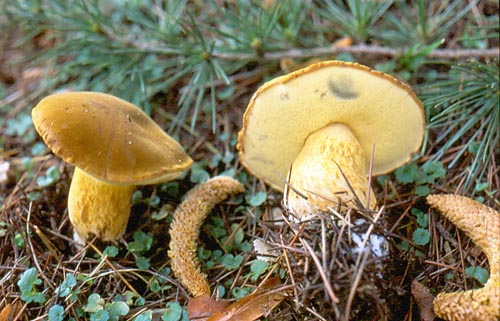Xerocomus Quél.
Recent molecular studies have shown that Xerocomus in its current circumscription is likely an artificial grouping and it is possible that it will be split at some point into smaller genera. Molecular studies also have changed our understanding about the species of xerocomoid boletes showing that morphological features are quite variable in this group. Not only microscopic study is essential for determination, but scanning electron microscope will be often needed in this “genus” as the spore ornamentation is not always seen under ordinary light microscope. Do bear in mind that macroscopic characters, such as colours, cracking cuticle, etc., tend to intergrade between the different species. Note that Boletus impolitus and Boletus depilatus that were shown to be close to Xerocomus subtomentosus and its allies, are here retained in Boletus for practical reasons. The same applies also for Phylloporus pelletieri, placed here in a genus of its own, but being also close to Xerocomus subtomentosus group.
Although large reference list will be found under most of the species, one should always consult Ladurner & Simonini (2003) having in mind that there are some new species (X. chrysonemus, X. marekii, X. silwoodensis) described after this otherwise superior book was printed. Useful keys, covering most of the European xerocomoid boletes (except some southern taxa) are provided by Knudsen & Vesterholt (2008), Hills (2008) and Kibby (2011), the later also featuring an excellent comparison chart.
Fruitbody medium to small sized, boletoid, without veil and ring. Stipe solid, often tapering towards the base. Flesh variously coloured, changing or not when exposed to air. Tubes not separable from each other, instead tearing apart. Pores usually angular.
Xerocomus heterodermus (Blum) Riva
Recently recognized and known to me only from the literature. It seems close to Xerocomus badius, but is distinguished on the account of the paler coloured dry velutinous cap, somewhat reminding Gyroporus castaneus or Xerocomus moravicus. From Xerocomus badius it is distinguished also by the pileipellis which is not gelatinized and is composed of hyphae with numerous congophilous granules .
Habitat. Recorded under Cedrus atlantica.
Distribution. Blum’s materials were collected in France and Alfredo Riva’s collection illustrated below originates from Switzerland.
Note. This is not Boletus heterodermus Singer, which is invalid later homonym of B. heterodermus Blum.
Photographs

Fruitbodies of Xerocomus heterodermus. Note the blueing pores and the velutinous cap surface. (photo A. Riva)

Fruitbodies of Xerocomus heterodermus. (photo A. Riva)
Important literature
Riva, A. 2011. Xerocomus heterodermus comb. nov. – Schweizerische Zeischrift für Pilzkunde 89: 200–203.